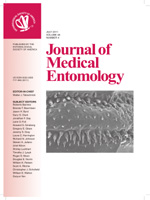An investigation of the Indian folk remedy plant Jatropha curcas L., was performed to identify the constituents responsible for the mosquito biting deterrent activity of the oil. J. curcas seed oil is burned in oil lamps in India and parts of Africa to repel biting insects, primarily mosquitoes. The seed oil was thoroughly analyzed by 1H NMR, 13C NMR, high-performance liquid chromatographyrefractive index, and gas chromatography-flame ionization detection to identify the constituents in the oil. Identified constituents, both free fatty acids and triglycerides, were evaluated for activity in Aedes aegypti (L.) (Diptera: Culicidae) biting deterrent assays. Furthermore, an oil condensation trap was used to demonstrate that free fatty acids or triglycerides are partially volatilized during the combustion process. These compounds were found to be responsible for the biting deterrency of the burned oil. Specifically, oleic, palmitic, linoleic, and stearic acids were all active at 25 nmol/cm2 above that of solvent control in Ae. aegypti biting deterrent assays. Oleic, palmitic, and linoleic acids were all more active than stearic acid in the same bioassay. Evaluation of the triglycerides containing each of these fatty acids revealed that tripalmitin, tristearin, trilinolein, and triolein all demonstrated significant activity above a solvent control at 10 µg/cm2, whereas tripalmitin was the most active. Due to literature reports suggesting larvicidal activity of the oil, J. curcas seed oil and its free fatty acid constituents also were evaluated against 1-d-old Ae. aegypti larvae up to 500 ppm. Oleic acid was the only fatty acid having larvicidal activity against 1-d-old Ae. aegypti larvae, with an LD50 of 47.9 ppm.
How to translate text using browser tools
1 July 2011
Identification of Mosquito Biting Deterrent Constituents from the Indian Folk Remedy Plant Jatropha curcas
Charles L. Cantrell,
Abbas Ali,
Stephen O. Duke,
Ikhlas Khan
ACCESS THE FULL ARTICLE
It is not available for individual sale.
This article is only available to subscribers.
It is not available for individual sale.
It is not available for individual sale.

Journal of Medical Entomology
Vol. 48 • No. 4
July 2011
Vol. 48 • No. 4
July 2011
Aedes aegypti
ethnobotany
insect repellent
Jatropha curcas
mosquitoes




